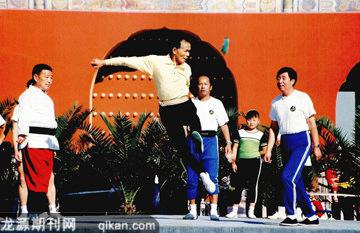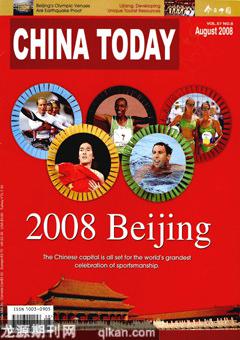People and Culture in Beijing
By staff reporters WANG JING&LI YAHONG

THERE are many places in Beijing where a visitor can get a glimpse of local culture. Many foreigners, whether they are from Europe, the United States, Africa or Latin America, often enjoy themselves by taking walks in local parks or along side streets, sipping tea in one of the old-style teahouses, watching a local opera, or visiting Panjiayuan, a marketfull of genuine – and sometimes less-than-genuine – antiques.
Morning Exercises in Beijings Parks
One of Beijings unique sights are the local middle-aged or retired people who do their morning exercises in the citys many attractive parks, either bykicking a shuttlecock (a Chinese version of hacky sack), practicing taiji boxing, qigong (a system of deep breathing exercises), sword dancing, or simply dancing. Today, more and more local people have become morning exercisers, and the time they exercise has become longer, in some places even lasting until noon.
Non-competitive sports are very popular in China. Some of them are uniquely Chinese, like qigong and taiji boxing, or shadow boxing as some people call it.Qigong has a history of over 2,000 years, and it allows its practitioners to achieve a harmony of mind and body. Taiji boxing has many styles and is practiced by millions. Free tutoring is offered at free exercise venues to help novices.
Kicking a shuttlecock as a game is a Chinese folk sport, which began in the Han Dynasty 2,000 years ago, as testified to by ancient brick carvings. The sport developed into four major schools during the Qing Dynasty over 100 years ago, when players often competed. Today, people are often seen standing in a circle enjoying it, and watching a skillful kicker is a true delight.
As folk sport activities are not limited by places, the number of participants and the form in which they are conducted, they have become part of local culture, and more than just a quest for good health.

Enjoying a Folk Opera in an
Old-style Theater
Passing a leisurely afternoon in an old-style theater, with fragrant hot tea resting on a local-style square table, nibbling at some old-Beijing snacks, like watermelon seeds, listening to the silky or vigorous Peking Opera being performed, shaking ones head gently from side to side to the rhythm of the singing, fingers tapping out the rhythm – that is a fair picture of the life of typical old Beijingers.More and more foreign visitors, apart from making necessary visits to the Palace Museum, the Summer Palace and the Great Wall, visit a theater like this to experienceold Beijing.
Zhengyici Theater, located in Beijings Xuanwu District, is just the right place to spend the afternoon, where highlights from Peking Opera and Kunqu are staged, and famous Chinese tea, local snacks, Peking Opera stage costumes and masks are available for sale.
In addition to old-style theaters, teahouses are another brilliant part of the local mosaic, though naturally teahouses can be found throughout China. However, the teahouses in Beijing are very different, reflecting the capital citys culture. Among the most celebrated is the Laoshe Teahouse, which owes its fame to the best-selling drama entitled Teahouse by Lao She, a highly popular writer and a native of Beijing. Every evening, local opera or other entertainmant is staged at the Laoshe, plus participatory activities related to tea serving, chess or musical instrument playing, painting and calligraphy.
If, like many Beijingers, one prefers more modern art forms – such as drama, Western opera and ballet – Beijing offers a wide range of choices.
The National Center for the Performing Arts to the west of Tiananmen Square is a man-made marvel, a complex of three parts consisting of the Western Opera Theater, the Chinese Opera Theater and a concert hall.
All four stages in the Western Opera Theater can be manipulated at will – lifted, lowered, pushed away and turned easily – and they are as advanced as those in the best theaters in France and Japan. Comparatively speaking, the Chinese Opera Theater is more functional, with its main stage a large rotating cylinder comprising 13 movable parts and two platforms. The music hall is in the eastern part of the National Center for the Performing Arts, designed for Western, Chinese and other music performances. Since it was completed, the center has been the venue for large scale ballet and orchestra performances by world-famous British and American troupes, as well as Kunqu plays by top Chinese performers.
Bars
– a Place to Relax
In terms of bars, among all the cities in China Beijing probably has the most, with up to 400. Most of their customers are foreigners, overseas students, successful Chinese merchants, white-collar workers, artists and fashionable college students.
Sanlitun, a bar street very close to the first and second foreign embassy areas, and frequented every day by foreigners, is well-known both inside and outside China. Since 1989, when the first bar made its home here, over 70 percent of the bars in Beijing have been located here. Bars as places for either business or socializing have become a widely accepted idea to many Chinese people.
Bars have also found a home around the lake of Shichahai. However, bars here are different from those in Sanlitun, for most of them are part of traditional Chinese residences. Even new bars have their exteriors and interiors fashioned in traditional residential architecture style, with very impressive Chinese-style window lattices, lanterns and walls adorned with Peking Opera masks. Customers coming here are more likely to be seeking a pleasant and quiet, rather than noisy, time. Drinking is not their main purpose, but rather to enjoy a serene moment with friends.
Finding Genuine Antiques
There are several places in Beijing foreigners like to frequent. The fame of Panjiayuan, a huge market for second-hand articles, folk-art and real artworks, has spread far and wide.Very close to it is the Antique City, the first second-hand market whose trade of antiques is under government supervision. It deals in old porcelain, painting and calligraphy by Chinese and foreign artists, jade, animal bone carvings, gold, silver, bronze works, classical Chinese furniture, old carpets, antique clocks and watches, and jewelry – whatever a collector may desire. It holds regular auctions for valuable artworks.
If you have silk on your mind, you cannot miss Xiushui Street outside Jianguomen, a place full of silk and cloth products, patterned T-shirts and traditionally Chinese attire. It is also a place for porcelain and jade hunters. Not only foreigners from nearby embassies, but tourists – both Chinese and foreign – and even well-known celebrities like French former president Jacques Chirac and Mrs. Susan Baker, wife of the former U.S. Secretary of State James Baker, once shopped here. Today, all the stalls in this famous place are housed inside the new Xiushui Building. They no longer do business on the street, as they did in the past.
Maliandao is a tea street with every sort of tea imaginable. Almost all the best tea produced in China comes from Chinas southwest, and the 700 tea businesses have all of them.
Museums, of course, are many in Beijing. Among the best known are the Folk Art and Local Customs Museum, the Capital Museum, the Military Museum, Chinas National Art Museum, the Palace Museum, the Red-House Art Museum, and Chinas National Science Museum, to name just a few.
The 798 Art Zone and the Songzhuang Artists Village are must-see places for art lovers. The former was transformed from deserted factory workshops, and has drawn thousands of visitors, among them many world-famous celebrities.
Compared with the 798 Art Zone, Songzhuang is outside of Beijing city proper, but it enjoys as much fame as the 798 Art Zone. Its location meets the needs of some artists who want to escape for a simple lifestyle. By 2008, over 1,000 artists have made it their home.

